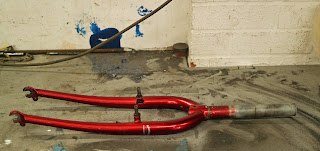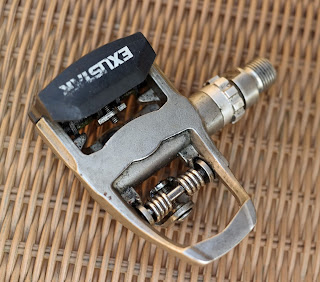I'm someone who keeps "doing" (as distinct from "to-do") lists. These are organic, and used to structure, and critically analyse how effectively I'm using time, and other resources. "To do lists are full of good intentions, but few results. Some might even describe them as "where good ideas go to die".
That established, instatiing the Univega's original (and recently refurbed) forks were on Saturday's agenda.
Organisation i.e. laying out tools, parts etc are all part of productivity. I'd suspected the long serving Tortec guards' stays were close to pensionable, so retrieved an SKS set, just in case.
Next came the crown race removal and setting tools, grease, Allen keys, two sets of cable cutters (Premium for cables, cheap n' cheerfuls for cable ties, and similar donkey work).
Going off piste, I decided to switch to these Genetic CX Cantilevers https://www.sevendaycyclist.com/genetic-cx-cantilever-brakes . I'm very fond of the IRD CAFAM 2 https://www.sevendaycyclist.com/ird-cafam-2-cantilever-brakes but fancied a change, and besides, the Genetic are much easier to set up.
I love a really firm, positive action, so set the spring tension to maximum, greased the "new" forks canti posts with Park PPL1 Poly lube and popped them aboard, before turning my attentions to disassembling the Univega's existing front end. Being a daily driver, I was pleasantly surprised by how easily everything released.
Full length mudguards (fenders) keep a remarkable amount of corrosive filth, from rider and machine, extending servicing times and ultimately, component life. I was pleasantly surprised by how much, effective Muc-Off Bio Grease https://www.sevendaycyclist.com/muc-off-bio-grease-long-term-test was still in evidence. Old "School chair" trials fork out. I gave the Aheadset's bottom race cursory inspection, before delivering a fresh helping, of the jam-ike grease.
Be rude (and silly) not to. I replace headsets/ forks maybe once yearly, so find this wallet friendly Ice Toolz crown race remover perfectly adequate. a few even taps later, I'd extracted the crown race and fitted it to the "new" forks, using my Cyclo setting tool.
Scrap "Gas pipe" down tubes make excellent, zero-cost alternatives, although ensure these have been cut cleanly, and accurately...
From this point, everything came back together, sans drama. Wheel reinstated, brakes setup, mudguard hardware greased and snugged tight, it was simply a case of setting bearing tension, trimming cables and naturally, treating the fork to some Velo 21 Ultimate paintwork protection https://www.sevendaycyclist.com/velo-21 .
I also took this opportunity to blast some corrosion inhibiting products inside the breathe holes, before hanging the bike up. This encourages it to travel through, and evenly coat the hosts. In a pinch, anything (petrochemical) oily will do. A teaspoon, or two of 10w/40 motor oil inside a frame, or delivered into the fork blades, via syringe will certainly help.
I chose to use up an almost exhausted aerosol, of waxy chain lube. Given the temperate weather, it should melt nicely and distribute evenly within their inner sanctum. Talking of which, Steve's been putting some Boeshield T-9 Bicycle Lube & Protectant through its paces
Last but not least, for this "sitting"; dynamo cable and computer sensors were tethered, to their respective blades. Weight might be a lesser consideration on a working bike and ultimately, I didn't weigh both forks. However, anecdotally, the originals are noticeably lighter (gun to my head, probably 300g), which for me, is another bonus.
Knew there was a reason I squirreled them away...
Continuing the working bike theme, co-editor Steve Dyster has been putting Bristol Bicycles Touring Bike through its paces and seems pleasantly surprised by its blend of fun and practicality.
Elsewhere, I've commenced testing Muc Off Dry Lube, which has a hue and odour, reminiscent of banana ice cream. It also has a recommended curing time of 4 hours, hence one I'd be inclined to re/apply the evening before riding. Once cured, it seems closer to a "diet" wax formula.
A formative forty mile blast suggests friction's lower than a snake's testicles but I'll reserve any kind of proper judgement, for another 250, or so. Be interesting to see how it compares with the quick curing Zefal Pro Dry https://www.sevendaycyclist.com/zefal-pro-dry-lube,

























































